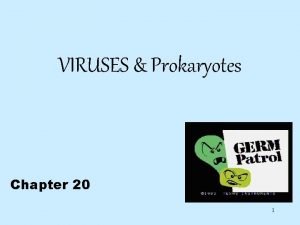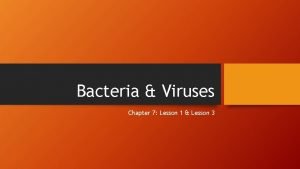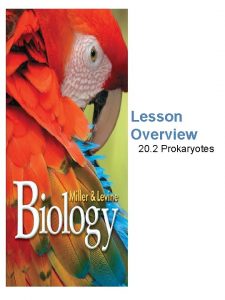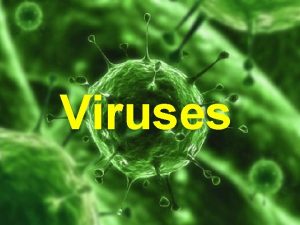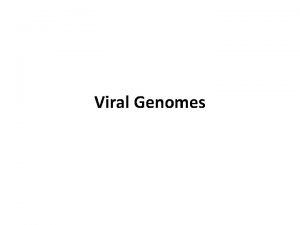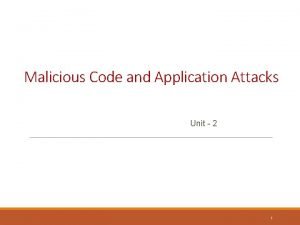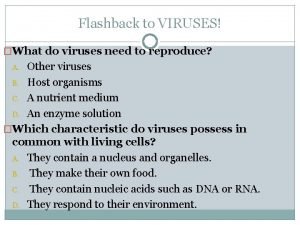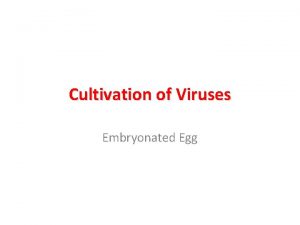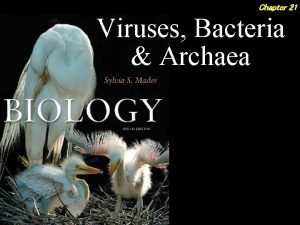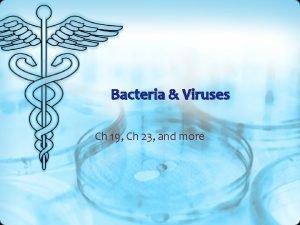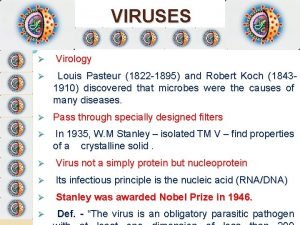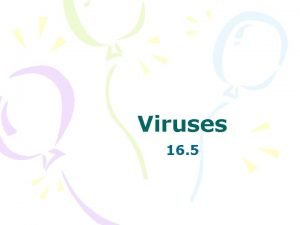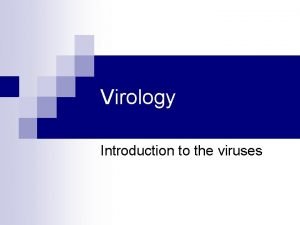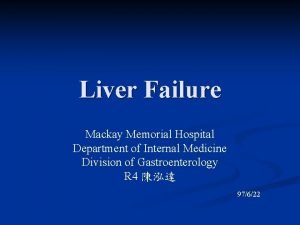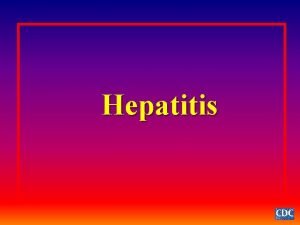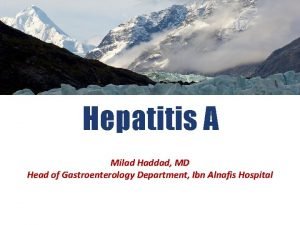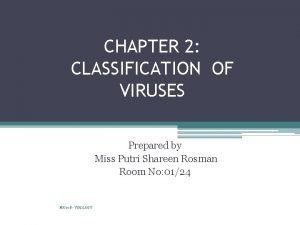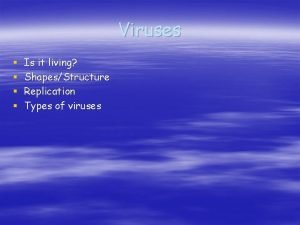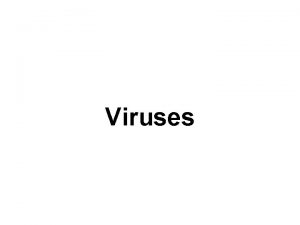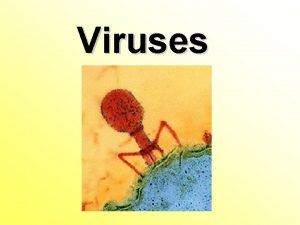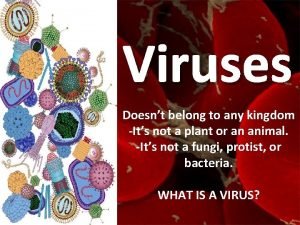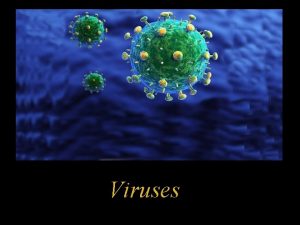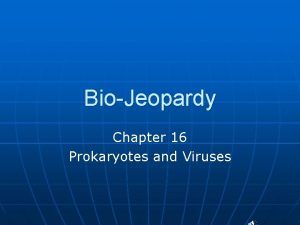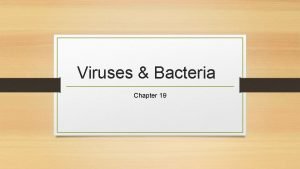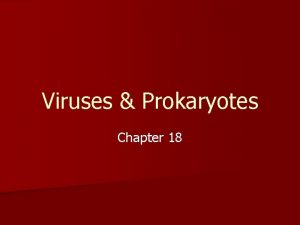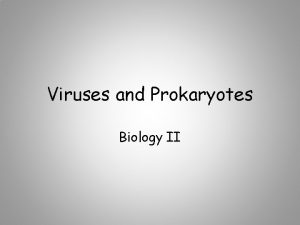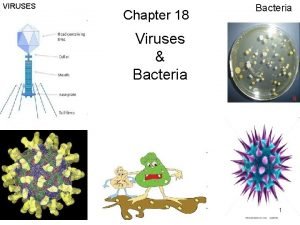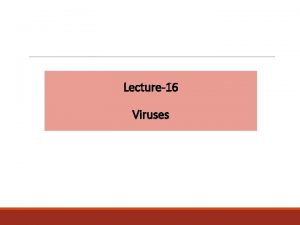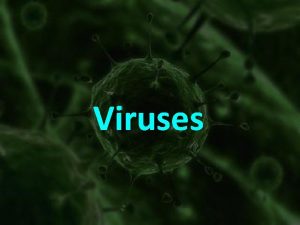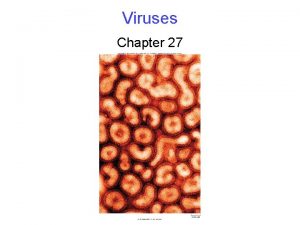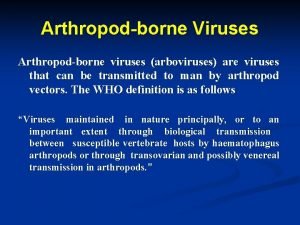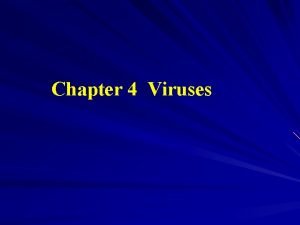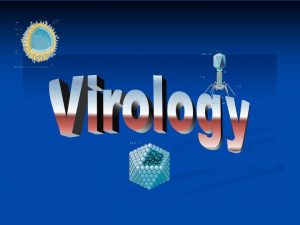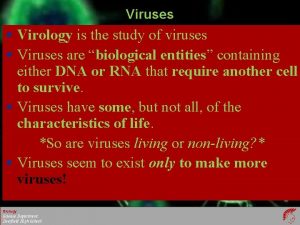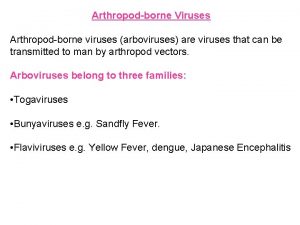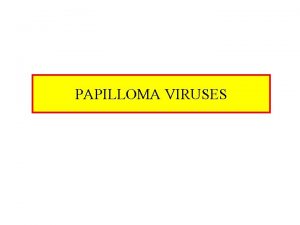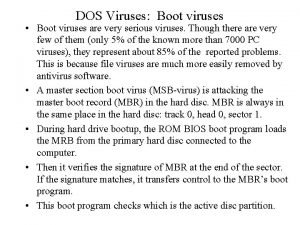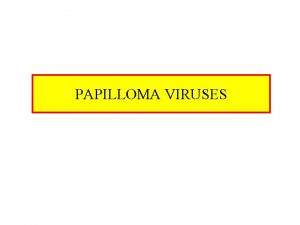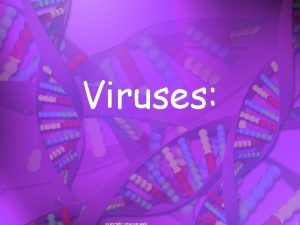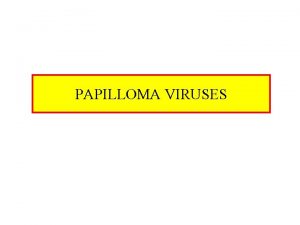Lesson Overview Viruses Lesson Overview 20 2 Prokaryotes






































- Slides: 38

Lesson Overview Viruses Lesson Overview 20. 2 Prokaryotes

Lesson Overview Viruses THINK ABOUT IT Imagine living all your life as a member of what you believe is the only family on your street. Then, one morning, you open the front door and discover houses and neighbors all around you. Where did all the people come from? What if the answer turned out to be that they had always been there—you just hadn’t seen them? How would your view of the world change?

Lesson Overview Viruses THINK ABOUT IT When the microscope was first invented, we humans had just such a shock. Far from being alone, we share every corner of our world with microorganisms. Even a seemingly clean toothbrush contains a film of bacteria on its bristles!

Lesson Overview Viruses Classifying Prokaryotes How are prokaryotes classified?

Lesson Overview Viruses Classifying Prokaryotes How are prokaryotes classified? Prokaryotes are classified as Bacteria or Archaea—two of the three domains of life.

Lesson Overview Viruses Classifying Prokaryotes The smallest and most abundant microorganisms on Earth are prokaryotes—unicellular organisms that lack a nucleus. Prokaryotes have DNA, like all other cells, but their DNA is not found in a membrane-bound nuclear envelope as it is in eukaryotes. Prokaryote DNA is located in the cytoplasm. A bacterium such as E. coli has the basic structure typical of most prokaryotes.

Lesson Overview Viruses Classifying Prokaryotes Recently, biologists have divided prokaryotes into two very distinct groups: Bacteria and Archaea. These groups are very different from each other; therefore, biologists now consider each group of prokaryotes as a separate domain. Eukaryotes are third domain.

Lesson Overview Viruses Bacteria The larger of the two domains of prokaryotes is the Bacteria include a wide range of organisms with lifestyles so different that biologists do not agree exactly how many phyla are needed to classify this group.

Lesson Overview Viruses Bacteria live almost everywhere—in fresh water, in salt water, on land, and on and within the bodies of humans and other eukaryotes. Escherichia coli, a typical bacterium that lives in human intestines, is shown.

Lesson Overview Viruses Bacteria are usually surrounded by a cell wall that protects the cell from injury and determines its shape. The cell walls of bacteria contain peptidoglycan—a polymer of sugars and amino acids that surrounds the cell membrane. Some bacteria, such as E. coli, have a second membrane outside the peptidoglycan wall that makes the cell especially resistant to damage.

Lesson Overview Viruses Bacteria In addition, some prokaryotes have flagella that they use for movement, or pili, which in E. coli serve mainly to anchor the bacterium to a surface or to other bacteria.

Lesson Overview Viruses Archaea Under a microscope, archaea look very similar to bacteria. Both are equally small, lack nuclei, and have cell walls, but there are important differences. The walls of archaea lack peptidoglycan, and their membranes contain different lipids. The DNA sequences of key archaea genes are more like those of eukaryotes than those of bacteria. Based on these observations, scientists have concluded that archaea and eukaryotes are related more closely to each other than to bacteria.

Lesson Overview Viruses Archaea Many archaea live in extremely harsh environments. One group of archaea produce methane gas and live in environments with little or no oxygen, such as thick mud and the digestive tracts of animals. Other archaea live in extremely salty environments, such as Utah’s Great Salt Lake, or in hot springs where temperatures approach the boiling point of water.

Lesson Overview Viruses Structure and Function How do prokaryotes vary in their structure and function?

Lesson Overview Viruses Structure and Function How do prokaryotes vary in their structure and function? Prokaryotes vary in their size and shape, in the way they move, and in the way they obtain and release energy.

Lesson Overview Viruses Size, Shape, and Movement Prokaryotes range in size from 1 to 5 micrometers, making them much smaller than most eukaryotic cells. Prokaryotes come in a variety of shapes. Rod-shaped prokaryotes are called bacilli. Spherical prokaryotes are called cocci. Spiral and corkscrew-shaped prokaryotes are called spirilla.

Lesson Overview Viruses Size, Shape, and Movement Prokaryotes can also be distinguished by whether they move and how they move. Some prokaryotes do not move at all. Others are propelled by flagella. Some glide slowly along a layer of slimelike material they secrete.

Lesson Overview Viruses Nutrition and Metabolism Prokaryotes need a supply of chemical energy, which they store in the form of fuel molecules such as sugars. Energy is released from these fuel molecules during cellular respiration, fermentation, or both.

Lesson Overview Viruses Nutrition and Metabolism Prokaryotes vary in the ways they obtain energy and the ways they release it. Looking at the two tables on the following slides, notice that some species are able to change their method of energy capture or release depending on the conditions of their environment.

Lesson Overview Viruses Nutrition and Metabolism: Energy Capture

Lesson Overview Viruses Nutrition and Metabolism: Energy Release

Lesson Overview Viruses Growth, Reproduction, and Recombination When a prokaryote has grown so that it has nearly doubled in size, it replicates its DNA and divides in half, producing two identical cells. This type of reproduction is known as binary fission.

Lesson Overview Viruses Growth, Reproduction, and Recombination Because binary fission does not involve the exchange or recombination of genetic information, it is an asexual form of reproduction. When conditions are favorable, prokaryotes can grow and divide at astonishing rates—some as often as once every 20 minutes!

Lesson Overview Viruses Growth, Reproduction, and Recombination When growth conditions become unfavorable, many prokaryotic cells form an endospore—a thick internal wall that encloses the DNA and a portion of the cytoplasm. Endospores can remain dormant for months or even years.

Lesson Overview Viruses Growth, Reproduction, and Recombination The ability to form endospores makes it possible for some prokaryotes to survive very harsh conditions. The bacterium Bacillus anthracis, which causes the disease anthrax, is one such bacterium.

Lesson Overview Viruses Mutations are one of the main ways prokaryotes evolve. Mutations are random changes in DNA that occur in all organisms. In prokaryotes, mutations are inherited by daughter cells produced by binary fission.

Lesson Overview Viruses Conjugation Many prokaryotes exchange genetic information by a process called conjugation. During conjugation, a hollow bridge forms between two bacterial cells, and genetic material, usually in the form of a plasmid, moves from one cell to the other.

Lesson Overview Viruses Conjugation Many plasmids carry genes that enable bacteria to survive in new environments or to resist antibiotics that might otherwise prove fatal. This transfer of genetic information increases genetic diversity in populations of prokaryotes.

Lesson Overview Viruses The Importance of Prokaryotes What roles do prokaryotes play in the living world?

Lesson Overview Viruses The Importance of Prokaryotes What roles do prokaryotes play in the living world? Prokaryotes are essential in maintaining every aspect of the ecological balance of the living world. In addition, some species have specific uses in human industry.

Lesson Overview Viruses Decomposers Bacteria called actinomycetes are present in soil and in rotting plant material such as fallen logs, where they decompose complex organic molecules into simpler molecules.

Lesson Overview Viruses Decomposers By decomposing dead organisms, prokaryotes, supply raw materials and thus help to maintain equilibrium in the environment. Bacterial decomposers are also essential to industrial sewage treatment, helping to produce purified water and chemicals that can be used as fertilizers.

Lesson Overview Viruses Producers Cyanobacteria in the genus Anabaena form filamentous chains in ponds and other aquatic environments, where they perform photosynthesis.

Lesson Overview Viruses Producers Photosynthetic prokaryotes are among the most important producers on the planet. Food chains everywhere are dependent upon prokaryotes as producers of food and biomass.

Lesson Overview Viruses Nitrogen Fixers All organisms need nitrogen to make proteins and other molecules. Nitrogen gas (N 2) makes up 80 percent of Earth’s atmosphere, but only a few kinds of organisms—all of them prokaryotes—can convert N 2 into useful forms. The process of nitrogen fixation converts nitrogen gas into ammonia (NH 3). Ammonia can then be converted to nitrates that plants use, or attached to amino acids that all organisms use. Nitrogen-fixing bacteria and archaea provide 90 percent of the nitrogen used by other organisms.

Lesson Overview Viruses Nitrogen Fixers Some plants have symbiotic relationships with nitrogen-fixing prokaryotes. The bacterium Rhizobium grows in nodules, or knobs, on the roots of legume plants such as soybean. The Rhizobium bacteria within these nodules convert nitrogen in the air into the nitrogen compounds essential for plant growth.

Lesson Overview Viruses Nitrogen Fixers The Rhizobium bacteria often live symbiotically within nodules attached to roots of legumes, such as clover, where they convert atmospheric nitrogen into a form that is useable by plants.

Lesson Overview Viruses Human Uses of Prokaryotes, especially bacteria, are used in the production of a wide variety of foods and other commercial products. Yogurt is produced by the bacterium Lactobacillus. Some bacteria can digest petroleum and remove human-made waste products and poisons from water. Other bacteria are used to synthesize drugs and chemicals through the techniques of genetic engineering. Bacteria and archaea adapted to extreme environments may be a rich source of heat-stable enzymes that can be used in medicine, food production, and industrial chemistry.
 Https://m..com/watch?v=nqecciuc7jy
Https://m..com/watch?v=nqecciuc7jy Youtube
Youtube Chapter 20 viruses and prokaryotes
Chapter 20 viruses and prokaryotes Chapter 20 viruses and prokaryotes
Chapter 20 viruses and prokaryotes Section 1 studying viruses and prokaryotes
Section 1 studying viruses and prokaryotes Lesson 1: viruses
Lesson 1: viruses Lesson 2 prokaryotes 1
Lesson 2 prokaryotes 1 Characteristics of bacteria
Characteristics of bacteria Lesson 2: prokaryotes: 1
Lesson 2: prokaryotes: 1 Prokaryotes are classified into
Prokaryotes are classified into Why are viruses considered nonliving?
Why are viruses considered nonliving? Which of the following is plant virus
Which of the following is plant virus General characteristics of viruses
General characteristics of viruses Viruses
Viruses Lysogenic viruses do not
Lysogenic viruses do not Section 19-3 diseases caused by bacteria and viruses
Section 19-3 diseases caused by bacteria and viruses Cultivation of viruses
Cultivation of viruses Egg inoculation technique
Egg inoculation technique Egrette chapter 21
Egrette chapter 21 Blood borne viruses
Blood borne viruses Are viruses alive yes or no
Are viruses alive yes or no Importance of viruses
Importance of viruses Why are viruses considered nonliving
Why are viruses considered nonliving General characters of viruses
General characters of viruses Helical virus
Helical virus Hepatotropic viruses
Hepatotropic viruses Hepatotropic viruses
Hepatotropic viruses Hepatotropic viruses
Hepatotropic viruses Milad haddad
Milad haddad Nomenclature of viruses
Nomenclature of viruses Chapter 18 section 1 bacteria
Chapter 18 section 1 bacteria Replication of viruses
Replication of viruses How do viruses differ from living things
How do viruses differ from living things Importance of viruses
Importance of viruses What does dna have that rna doesnt
What does dna have that rna doesnt Best viruses
Best viruses Best viruses
Best viruses Jobpair
Jobpair Virinae
Virinae




